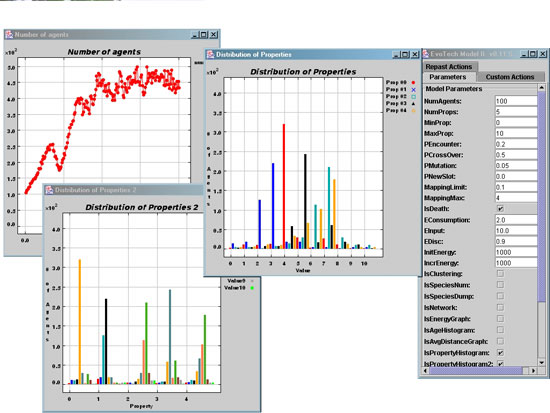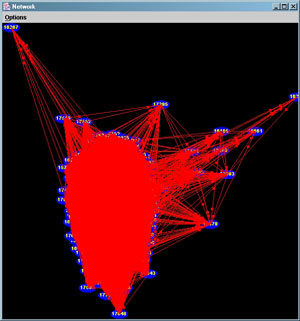
This issue in pdf Archive: Next issue: Next Special theme: |
|
|||||
Causal Structures in Embodied Systemsby George Kampis and László Gulyás Embodied cognition is the front line of cognitive research. The Cognitive Science Program at Eötvös Loránd University in Budapest is running a project in cooperation with SZTAKI and other institutions. In its current phase, the project aims to develop simulations based on causal principles that unify autonomous robots, evolutionary processes and cognitive systems, thereby testing basic principles of open-ended real-world intelligence through interaction. In the last decade it has become generally clear that human and animal cognition is based on embodied functioning rather than abstract representation. To operate an embodied system, sensory-motor loops, learning, and situated actions coordinated by low-level control are necessary, rather than reasoning, planning, or knowledge. This recognition has led to a shift in emphasis in cognitive systems research. Instead of representation, situatedness and environmental action are believed to supply essential information for the agent. The new approach is supported by findings in developmental child psychology and cognitive linguistics, and by the dynamic view of cognition. Most of the current models developed in this new spirit are anti-representational in the same sense as old cybernetics, where every material function was reduced to feedback mechanisms and dynamic control. In the embodied framework, research on genuinely cognitive structures is neglected. An additional problem is that embodiment tends to invite a controversial focus on internal experience, a factor that is not accessible to scientific modelling. Our research started from the hypothesis that there exist intermediate cognitive structures between situated behaviour and mental experience, and that through these we can get a handle on cognitive functions. Recent interest in systems where motor control, neural learning, vision and symbol systems meet can supply a similar assumption. The paradigm of embodied cognition must switch its focus of inquiry from lower-level, insect-like intelligence, which has dominated earlier research, to vertebrate cognition. The area in which higher organisms are superior to lower organisms is the integrated use of their various faculties. We are looking at how this may happen. The Primacy of Causality An example is the orchestrated use of different sensory modalities in active perception where, for instance, a visually guided mental model can recursively enact actions that approach the signal and lead to new percepts that help in stabilising the mental model. Here the underlying concept is that of a complex body with context-dependent causal faculties, as opposed to a simple one that receives externally fixed inputs. An Application: Evolutionary Technology Evolution and cognition have striking parallels. In both cases it is complex bodily properties of a physically realised agent that collectively determine a historical process of structure formation, which we often view from the perspective of its end results. If we want to understand the process of origin of the inner structure and the role that real-world causality plays in it, evolution is a good starting point. Evolution is also a useful example for applying causal concepts of embodiment because equipping abstract systems with causal powers may help us to understand what makes an evolutionary process work. Selection is only half of the answer, as was recently demonstrated by studies on robotic as well as software-based systems, which failed to improve beyond a certain point. The same causal principle that underlies active perception can also assist selection. The assumption is that an adaptation that produces a new phenotype can also switch interactions between organisms to a different causal mode, which makes a new adaptive process possible.
We developed an agent-based simulation model using the RePast package. Organisms are agents that selectively feed, reproduce and die, based on their phenotypic properties described in variable length records. As adaptation progresses, new property sets extend the records, and as a result, selection can spontaneously switch between the defining properties of an interaction. The aim is to develop functionally disjoint subpopulations specialised for the use of different property sets. The first results have recently been reported, showing the possibility of progressive evolution productive of new selection effects, as an illustration for the causal principles of embodiment. Some steps of the ongoing research outlined in this article were carried out while George Kampis was Fujitsu Visiting Associate Professor at the Japan Advanced Institute of Science and Technology and during the visit of László Gulyás at Harvard's Center for Basic Research in the Social Sciences (CBRSS). Links: Please contact: |
|||||



